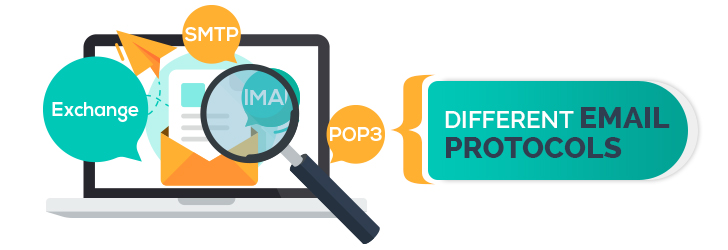
When we speak about email accounts, there are multiple protocols that are involved. This can be extremely confusing if you are not aware of what protocols exist for emails. Also, each of these protocols performs slightly different functionality. The commonly used protocols are- IMAP, POP3, SMTP, and Exchange. These are a few protocol types one would come across while accessing an email client. The protocol details can be accessed via the server settings based on the email client being used.
POP3
POP3 stands for Post Office 3 protocol, and it is used for retrieving emails. POP simply reaches out to the mail server and brings back the mail contents. This is a simple yet standardized way that allows users to access mailboxes and quickly download messages to their devices.
With POP3, users can configure the server settings. This can be used to allow mail copies to be left on the server or move all emails without leaving any copy on the server. This is usually configurable in most cases. The biggest advantage of POP3 is the low dependency on the Internet. Users can download all emails and read them at leisure even if they are accessing this offline.
The way these emails are stored locally depends on the email client. For instance, Outlook utilizes .pst, while Thunderbird uses .mbox. This is a good option in case you choose to read emails offline. Apart from this, this helps you reduce the server space by storing messages locally.
The default ports for POP3 are:
- Port 110 – This is the default non-encrypted port.
- Port 995 – This is the default port for secure connections.
IMAP
This stands for Internet Message Access Protocol, and it is also used to retrieve emails. This again is a standard protocol for accessing emails and is a client/server protocol. Here the emails are received and held by the Internet server. Unlike POP, this does not move the emails. The biggest difference between POP3 and IMAP is the mail sync-up. POP3 assumes that a user will be connected to a single device. However, IMAP is suitable for different devices simultaneously.
IMAP requires users to be constantly connected to the Internet. When a user accesses the mailbox, the user is actually connected to an external server. This is more beneficial when there are multiple users. IMAP can work over a relatively low internet connection since it only downloads email messages from the server when a user has requested to read a specific email.
The default ports for IMAP are:
- Port 143 – This is the default non-encrypted port.
- Port 993 – This is the default port for secure connections.
SMTP
This stands for Simple Mail Transfer Protocol. This is a standard protocol for sending emails over the Internet. This is a protocol that is used by a Mail Transfer Agent to deliver emails to a recipient’s email server. This is a protocol that defines mail sending and cannot be used for mail receiving.
SMTP is the most commonly used protocol for mail transfer between two servers. This requires no authentication to function, unlike POP3 and IMAP. Certain Internet Service Providers block the default port 25 of SMTP. In such cases, the mail server also provides an alternate secondary port.
The default port for SMTP is:
- Port 25 – This is the default non-encrypted port.
- Port 465/ 587 – This is the default port for secure connections.
HTTP
This is a commonly known protocol and stands for HyperText Transfer Protocol. This is not an email-specific protocol. However, HTTP is used for email access using web-based emails (i.e. webmail). Hotmail and Gmail are examples of using HTTP as email clients. This is used to compose and retrieve emails from a web-based account.
The default port for HTTP is:
- Port 80 – This is the default non-encrypted port.
- Port 443 – This is the default port for secure connections.
Exchange Account (EAS – Exchange ActiveSync)
This is used by Exchange servers like Microsoft Exchange. This not only syncs mail but also syncs contacts, calendars, notes, and everything in outlook. The advantage is that users can have a synced copy of the calendar, and contacts over multiple devices.
Conclusions
There are various email protocols that are used to send and receive emails. For retrieving emails, IMAP is the preferred protocol of choice as it accesses the emails directly from the server while SMTP is the protocol used to send emails. IMAP uses ports 143 (unencrypted), or 993 (encrypted) while SMTP uses ports 25 (unencrypted) and 445 or 587 for encrypted traffic.
Share this post
Leave a comment
All comments are moderated. Spammy and bot submitted comments are deleted. Please submit the comments that are helpful to others, and we'll approve your comments. A comment that includes outbound link will only be approved if the content is relevant to the topic, and has some value to our readers.

Comments (0)
No comment